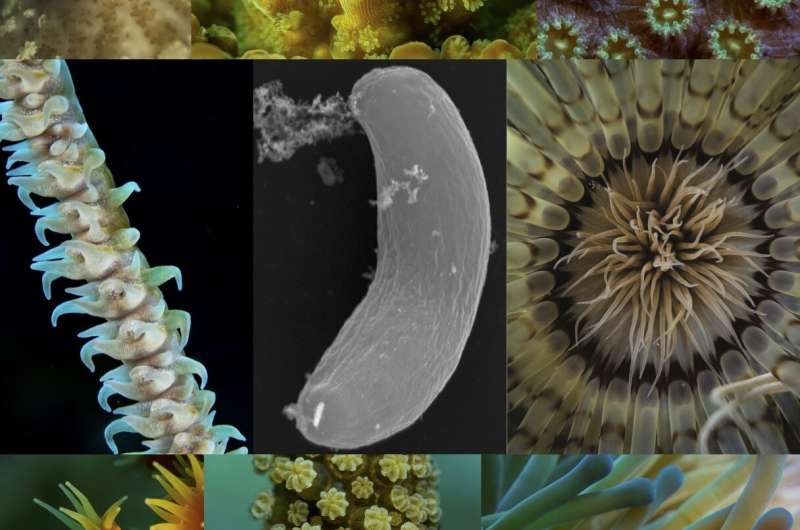Corallicolids and their hosts. A variety of anthozoan animals surrounding a corallicolid (centre: SEM of Anthozoaphila gnarlus). Clockwise from top left: Rhodactis (the type host of Corallicola aquarius), the complex scleractinian Acropora, the robust scleractinian Orbacella, the tube-dwelling anemone Pachycerianthus, the actiniarian anemone Condylactis, the gorgonian Eunica, the zoanthid Parazoanthus, and the black coral Cirrhipathes. Credit: Keeling PJ et al., 2021, PLOS Pathogens, CC-BY 4.0 (creativecommons.org/licenses/by/4.0/)
In a Pearls article publishing September 16th in the open-access journal PLOS Pathogens, Patrick Keeling and colleagues at the University of British Columbia in Canada describe investigations into an enigmatic group of coral-infecting microbes.
Coral reefs provide homes for biodiverse ecosystems including fishes, mollusks, and crustaceans, and inside their cells, they also harbor a diverse community of microbes. The best-known are photosynthetic symbionts in the genus Symbiodiniaceae, which provide essential ingredients to build the corals' calcium-carbonate skeleton, in return for protection and fuel for photosynthesis. However, over the past two decades, researchers have identified millions of new eukaryotic sequences associated with corals, including a mysterious group of microbial parasites called Corallicolida. First discovered by accident as artifacts in molecular ecological surveys, and eventually isolated from an aquarium, Corallicolida live inside coral cells. Corallicolida are colorless and their genomes lack key genes needed for photosynthesis, indicating that they are not photosynthetic symbionts like the Symbiodiniacea. Perhaps, ecologists wondered, the Corallicolida are the descendants of a once-beneficial photosynthetic symbiont that lost its photosynthetic machinery and became a parasite. However, so far there is no evidence that they cause any harm to their host. In fact, Corallicolida don't seem to have any major effect—good or bad—on the coral cells they inhabit.
A further twist in the story came with the discovery that, despite lacking genes for photosystems or photosynthetic reaction centers, the Corallicolida genome includes genes for the four types of chlorophyll. The chlorophyll genes are expressed in Corallicolida cells and are subject to purifying natural selection—indications that they are still playing some role in the cell. Exactly what that role might be remains unclear, and much more research is needed to determine whether the Corallicolida are friends or foes to reef-building corals, the authors say.
"Coral reefs are an important marine habitat and well-studied biodiversity hotspot, so the fact that so many corals around the world are infected with an intracellular parasite that had hardly even been noticed is a testament to how little we know about microbial biodiversity," Keeling adds. "For years these parasites were largely known only from hints buried in large-scale molecular sequence surveys, so hopefully by connecting a few dots to link up pictures, sequences, and host identification we can now start to look more deeply into how they infect, spread between hosts, and what effects they have on coral health."
More information: Keeling PJ, Mathur V, Kwong WK (2021) Corallicolids: The elusive coral-infecting apicomplexans. PLoS Pathog 17(9): e1009845. doi.org/10.1371/journal.ppat.1009845
Journal information: PLoS Pathogens
Provided by Public Library of Science
























